 Every year, world leaders gather to find ways of limiting global warming. The latest of these ‘COP’ meetings, COP30, is in Belém, Brazil from 10 to 20 November 2025. COP stands for ‘Conference of the Parties’, the decision-making body of the United Nations Framework Convention on Climate Change (UNFCCC).
Every year, world leaders gather to find ways of limiting global warming. The latest of these ‘COP’ meetings, COP30, is in Belém, Brazil from 10 to 20 November 2025. COP stands for ‘Conference of the Parties’, the decision-making body of the United Nations Framework Convention on Climate Change (UNFCCC).
Perhaps the best-known of these meetings was in Paris in 2015. This resulted in the Paris Agreement. This is a legally-binding international treaty to limit global warming to well below 2°C and preferably to 1.5°C above pre-industrial levels. This would involve reducing greenhouse gas emissions and/or taking carbon absorbing measures. All UN countries except for Iran, Libya and Yemen are signatories to the agreement.
However, on coming to office in January 2025, President Trump announced that the USA will withdraw from the agreement in January 2026. Instead, he would prioritise fossil fuel production, under the mantra, ‘drill, baby, drill’. Previously he had claimed that global warming is a hoax concocted by China designed to undermine the competitive power of the USA.
Progress in reducing emissions and mitigating climate change
 Since 2020, each country has been required to submit its own emissions-reduction targets, known as ‘nationally determined contributions’ (NDCs), and the actions it will take to meet them. Every five years each country must submit a new NDC more ambitious than the last. New NDCs are due this year. As of 12 November, 112 of the 197 countries had submitted a new NDC (including the USA, China, the EU and the UK). These 112 countries account for around 71 per cent of global emissions.
Since 2020, each country has been required to submit its own emissions-reduction targets, known as ‘nationally determined contributions’ (NDCs), and the actions it will take to meet them. Every five years each country must submit a new NDC more ambitious than the last. New NDCs are due this year. As of 12 November, 112 of the 197 countries had submitted a new NDC (including the USA, China, the EU and the UK). These 112 countries account for around 71 per cent of global emissions.
Implementing all new NDCs would reduce global CO2 emissions by between 15 and 25 per cent from current levels by 2035. But this would merely reduce global warming to around 2.6°C above pre-industrial levels. Approximately 35 per cent emissions reductions by 2035 would be required to restrict global warming to 2°C and 55 per cent to restrict it to 1.5°C.
But implementing the Paris Agreement has still had a high degree of success. Without the action taken and being taken over the past 10 years, it is predicted that global temperatures by 2050 would rise by 3–3.5°C.
Rich countries are expected to provide finance to low-income countries. This is required to help such countries adopt green technologies and to adapt to the harmful effects of climate change (e.g. through irrigation schemes and flood defences). At COP29 in Azerbaijan, the ‘Baku Finance Goal’ was agreed. This is an agreement to provide climate finance of $1.3 trillion per year by 2035 to developing countries from all public and private sources.
The subsequent ‘Baku to Belém Roadmap’ provides a set of suggested actions for governments, financial institutions and the private sector to bridge the gap between current climate finance flows and the $1.3 trillion agreed to meet global climate goals. The roadmap is a central focus of the COP30 conference in Belém, with discussions between countries on how to translate the Baku finance goal into concrete, tangible actions and integrate it into formal decisions.
The role of Donald Trump
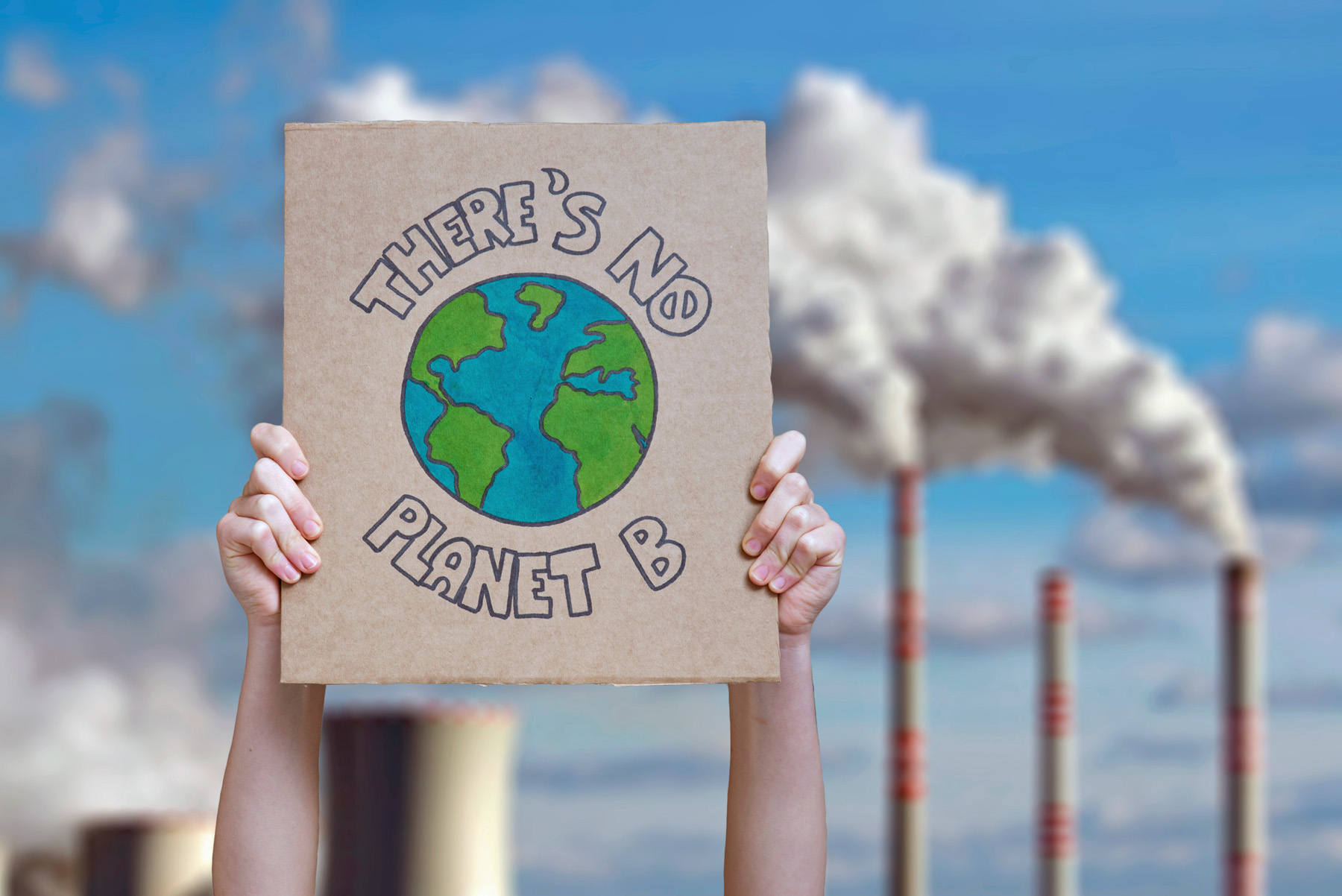 As well as announcing that the USA will withdraw from the Paris Agreement in January 2026, since coming to office in 2025, President Trump has given billions of dollars of tax cuts to fossil fuel firms and allowed drilling for oil and gas on federal lands. At the same time, he has described renewable energy as ‘a joke’ that will bankrupt countries and has slashed subsidies and tax breaks for solar and wind power, withdrawn permits for wind and solar farms, and cut funding for green energy research.
As well as announcing that the USA will withdraw from the Paris Agreement in January 2026, since coming to office in 2025, President Trump has given billions of dollars of tax cuts to fossil fuel firms and allowed drilling for oil and gas on federal lands. At the same time, he has described renewable energy as ‘a joke’ that will bankrupt countries and has slashed subsidies and tax breaks for solar and wind power, withdrawn permits for wind and solar farms, and cut funding for green energy research.
He wants the USA to be world leader in fossil fuel energy, calling on governments to buy US oil and gas, threatening some countries with tariffs if they do not. Already, Japan, South Korea and several European countries have agreed to buy huge quantities of US oil and liquefied natural gas (LNG). A worry is that other similarly inclined governments, such as Argentina, may roll back on their commitments to a green transition and instead boost their fossil fuel industries.
This gives added urgency to the Belém talks. It is crucial for the rest of the world to stick together in pushing ahead to combat global warming and in adopting and sticking to tough NDCs. It is also crucial for rich countries to support dlow-income countries in adopting climate-friendly investment and in measures to mitigate the effects of global warming.
The economics of climate change
 Climate change is directly caused by market failures. One of the most important of these is that the atmosphere is a common resource: it is not privately owned; it is a global ‘commons’. Individuals and firms use it at a zero price. If the price of any good or service to the user is zero, there is no incentive to economise on its use. Thus for the emitter there are no private costs of using the atmosphere in this way as a ‘dump’ for their emissions and, in a free market, no incentive to reduce the climate costs.
Climate change is directly caused by market failures. One of the most important of these is that the atmosphere is a common resource: it is not privately owned; it is a global ‘commons’. Individuals and firms use it at a zero price. If the price of any good or service to the user is zero, there is no incentive to economise on its use. Thus for the emitter there are no private costs of using the atmosphere in this way as a ‘dump’ for their emissions and, in a free market, no incentive to reduce the climate costs.
And yet when firms emit greenhouse gases into the atmosphere there are costs to other people. To the extent that they contribute to global warming, part of these costs will be borne by the residents of that country; but a large part will be borne by inhabitants of other countries.
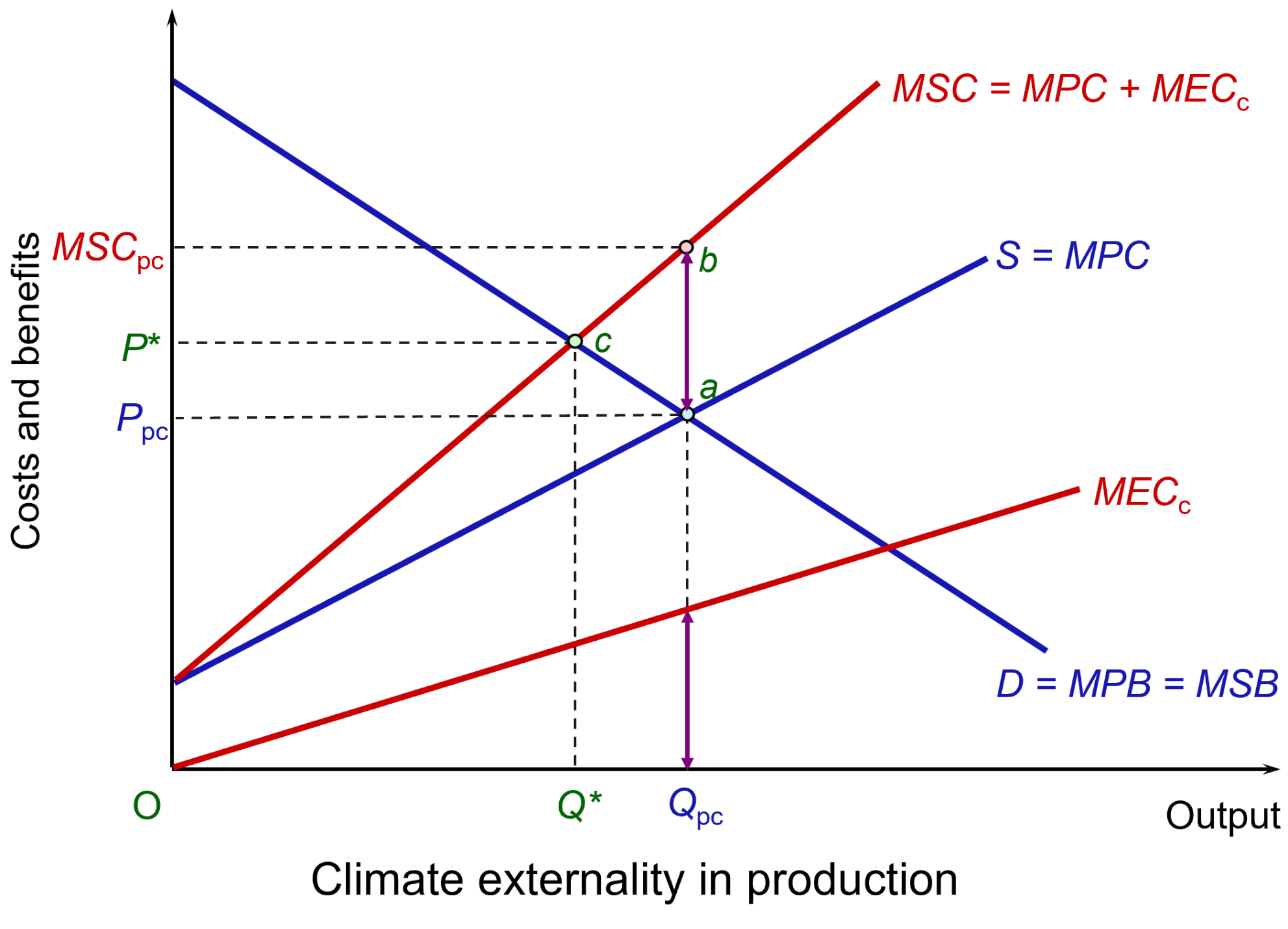 These climate costs are external costs to the firm and are illustrated in the figure. It shows an industry that emits CO2. To keep the analysis simple, assume that it is a perfectly competitive industry with demand and supply given by curves D and S, which are equal to the marginal private benefits (MPB) and marginal private costs (MPC), respectively. There are no externalities on the demand side and hence MPB equals the marginal social cost (MSB). Market equilibrium is at point a, with output at Qpc and price at Ppc. (Click here for a PowerPoint.)
These climate costs are external costs to the firm and are illustrated in the figure. It shows an industry that emits CO2. To keep the analysis simple, assume that it is a perfectly competitive industry with demand and supply given by curves D and S, which are equal to the marginal private benefits (MPB) and marginal private costs (MPC), respectively. There are no externalities on the demand side and hence MPB equals the marginal social cost (MSB). Market equilibrium is at point a, with output at Qpc and price at Ppc. (Click here for a PowerPoint.)
Assume that the emissions create a marginal cost to society equal to MECc. Assume that the MEC increases as output and total emissions increase. The MECc line is thus upward sloping. At the market price of Qpc, these external climate costs are equal to the purple vertical line. When these external climate costs are added to private costs, this gives a marginal social cost given by MSC = MPC + MECc. The gives a socially optimal level of output of the product of Q* at a price of P*, with the optimum point of c.
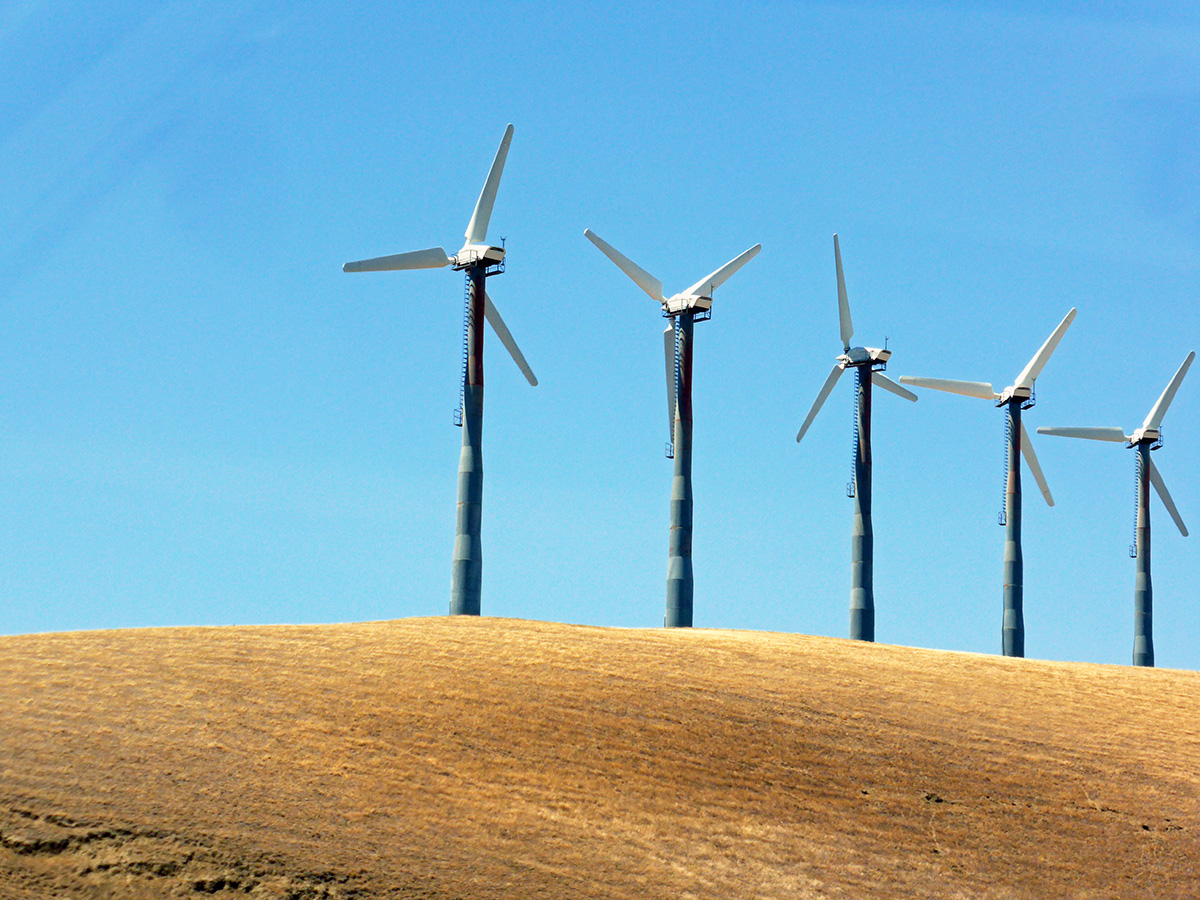 In other words, other things being equal, the free market overproduces products with climate externalities. If the output is to be reduced to the social optimum of Q*, then the government will need to take measures such as those advocated in the Paris Agreement. These could include imposing taxes on products, such as electricity generated by fossil fuels, or on the emissions themselves. Or green alternatives, such as wind power, could be subsidised.
In other words, other things being equal, the free market overproduces products with climate externalities. If the output is to be reduced to the social optimum of Q*, then the government will need to take measures such as those advocated in the Paris Agreement. These could include imposing taxes on products, such as electricity generated by fossil fuels, or on the emissions themselves. Or green alternatives, such as wind power, could be subsidised.
Alternatively, regulations could be used to cap the production of products creating emissions, or caps on the emissions themselves could be imposed. Emissions permits could be issued or auctioned. Only firms in possession of the permits would be allowed to emit and the permits would cap emissions below free-market levels. These permits could be traded under a cap-and-trade scheme, such as the EU’s Emissions Trading Scheme. Again, such schemes are advocated under the Paris Agreement.
COP30 and progress in tackling climate change
 The USA is not attending COP30 in Brazil. Nor is the Chinese leader, Xi Jinping. However, there are growing opportunities for translating aims into practical policies for specific sectors, such as energy, transport and carbon-intensive industries. These policies may require some degree of government action – taxes, subsidies or regulation – to internalise climate externalities. But increasingly, green alternatives are becoming economically viable without subsidies or with just initial government funding to ‘crowd in’ private investment, which will then attract further private capital as external economies of scale kick in. Increasingly investors will find profitable opportunities in climate-friendly projects.
The USA is not attending COP30 in Brazil. Nor is the Chinese leader, Xi Jinping. However, there are growing opportunities for translating aims into practical policies for specific sectors, such as energy, transport and carbon-intensive industries. These policies may require some degree of government action – taxes, subsidies or regulation – to internalise climate externalities. But increasingly, green alternatives are becoming economically viable without subsidies or with just initial government funding to ‘crowd in’ private investment, which will then attract further private capital as external economies of scale kick in. Increasingly investors will find profitable opportunities in climate-friendly projects.
At the same time, while the USA is moving away from climate-friendly investment (as least for the term of the Trump Presidency), China is moving in the opposite direction, with massive investment in solar panels, wind turbines, EVs and batteries – investment that is bringing down their cost and thereby encouraging their adoption around the world. Such technologies create huge opportunities for low-income countries to provide affordable energy and to create local jobs, both skilled and unskilled. It also helps them achieve much greater energy security by reducing their reliance on fossil fuel imports
Chinese advances in green technology are also providing a stimulus to other countries to invest in renewable industries to prevent Chinese dominance. The danger, however, of Chinese dominance in the renewable sector in high-income countries is that it may encourage them to impose tariffs on Chinese imports of EVs, solar panels, etc. to protect their own industries.
But despite the growing opportunities for profitable adoption of green technologies without government support, there is still much that governments need to do to encourage the process. COP meetings are an important forum for discussing such policies and holding governments to account for meeting or not meeting their targets.
The agreement
The agreement reached at the end of the conference marked relatively small progress. There was agreement to increase finance from developed to developing countries to help them adapt to climate change. This would triple to $120bn per year, up from the previously agreed doubling, but the target date was pushed back to 2035 from the previously agreed 2030.
By the end of the conference, 122 of the 197 countries had submitted a new NDC – still 75 countries short, although others are expected.
The conference also agreed to establish a ‘just transition mechanism (JTM)’ to ‘enhance international cooperation, technical assistance, capacity-building and knowledge-sharing, and enable equitable, inclusive just transitions’. However, this is voluntary and no funding was attached, but it could act as the basis for future funding.
The biggest failure of the conference was probably the lack of agreement on phasing out of fossil fuels. This is not surprising given the opposition of the major oil producers. The hope is that the reduction in costs of renewable energy will drive the process anyway – a process that China is keen to accelerate with its investment in solar power and other renewable energy. One hopeful development, however, was the pledging of more than $9bn to halt deforestation, a major source of global warming. (See the Travers Smith article at the end of the Articles list below for a very useful summary of the outcome.)
Articles
- What is COP30 and why does it matter for the climate?
Chatham House, Anna Åberg (5/9/25)
- COP30 in Brazil: What is at stake for global collaboration on climate and nature?
World Economic Forum, Pim Valdre (5/11/25)
- What is COP30 and why does it matter?
CNN, Laura Paddison (11/11/25)
- Why COP 30 in Brazil Matters for a Thriving Economy and a Safe, Livable Planet
Union of Concerned Scientists (UCS),Rachel Cleetus (7/11/25)
- Nationally Determined Contributions: The Action Plans Behind Global Efforts To Fight the Climate Crisis
Center for American Progress (CAP, Kalina Gibson and Courtney Federico (22/9/25)
- New climate pledges only slightly lower dangerous global warming projections
UN Environment Programme, Press Release (4/11/25)
- COP30: Trump and many leaders are skipping it, so does the summit still have a point?
BBC News, Justin Rowlatt (10/11/25)
- Trump dismisses clean energy as ‘a joke.’ But Americans deserve facts, not fear
USA Today, Mark McNees (23/9/25)
- The surprising countries pulling off stunningly fast clean energy transitions
CNN, Ella Nilsen and Samuel Hart (7/11/25)
 Could the world’s biggest polluter be its savior against climate change?
Could the world’s biggest polluter be its savior against climate change?CNN, Simone McCarthy (17/11/25)
- COP 2025: Outlook and Implications for Investors
RankiaPro, Joanna Piwko, Allegra Ianiri, Marie Lassegnore and Jean-Philippe Desmartin (10/11/25)
Post-agreement
- Belém: yet another cop out
Zero Hour, Allan Gray (25/11/25)
- Cop30’s watered-down agreements will do little for an ecosystem at tipping point
The Guardian, Fiona Harvey, Jonathan Watts, Damien Gayle and Damian Carrington (22/11/25)
- COP30: Five key takeaways from a deeply divisive climate summit
BBC News, Justin Rowlatt and Matt McGrath, (25/11/25)
- COP30: What were the key outcomes?
Travers Smith (1/12/25)
Information and Data
Questions
- Summarise the Paris Agreement.
- Summarise the Baku to Belém Roadmap to 1.3T.
- What incentives are there for countries to stick to their NCDs?
- Using a diagram similar to that above, illustrate how the free market will produce a sub-optimal amount of solar power because the marginal social benefit exceeds the marginal private benefit. How might the calculation be changing?
- How might game theory be used to analyse possible international decision making at COP conferences? How might this be affected by the attitudes of the Trump administration?
- Is it in America’s interests to cease investing in green energy and green production methods?
 On the day he came to office, President Trump signed a series of executive orders. One of these was to set in motion the process of withdrawing from the UN Paris climate agreement. Section 3(a) of the order reads:
On the day he came to office, President Trump signed a series of executive orders. One of these was to set in motion the process of withdrawing from the UN Paris climate agreement. Section 3(a) of the order reads:
The United States Ambassador to the United Nations shall immediately submit formal written notification of the United States’ withdrawal from the Paris Agreement under the United Nations Framework Convention on Climate Change.
The Paris Agreement is an international treaty on climate change. It was adopted on 12 December 2015 and came into force on 4 November 2016, 30 days after the point was reached when at least 55 countries accounting for at least 55% of global emissions had ratified the treaty.
Currently, all UN countries are signatories to the agreement and only Iran, Libya and Yemen are yet to ratify it. The agreement commits countries to limiting global warming to well under 2°C above pre-industrial levels and preferably to no more than 1.5°C. This would involve reducing greenhouse gas emissions and/or taking carbon absorbing measures.
 Since 2020, each country has been required to submit its own emission-reduction targets, known as ‘nationally determined contributions’ (NDCs), and the actions it will take to meet them. Every five years each country must submit a new NDC more ambitious than the last.
Since 2020, each country has been required to submit its own emission-reduction targets, known as ‘nationally determined contributions’ (NDCs), and the actions it will take to meet them. Every five years each country must submit a new NDC more ambitious than the last.
Rich countries are expected to provide finance to low-income countries. This is required to help poor countries adopt green technologies and to adapt to the harmful effects of climate change (e.g. through irrigation schemes and flood defences).
Countries set target dates by which emissions would be fully offset by carbon absorption measures (‘net zero’). The UN’s goal is to reach global net zero by 2050. According to the UN Climate Action site:
As of June 2024, 107 countries, responsible for approximately 82 per cent of global greenhouse gas emissions, had adopted net-zero pledges either in law, in a policy document such as an national climate action plan or a long-term strategy, or in an announcement by a high-level government official. More than 9000 companies, over 1000 cities, more than 1000 educational institutions, and over 600 financial institutions have joined the Race to Zero, pledging to take rigorous, immediate action to halve global emissions by 2030.
The Paris Agreement has helped to cut emissions or slow their rate of growth in most countries. Although net zero by 2050 may be unlikely, warming will be less than without the agreement.
The USA and the Paris Agreement
 In April 2016 the USA signed the Paris Agreement. As stated above, the Paris Agreement came into effect on 4 November 2016.
In April 2016 the USA signed the Paris Agreement. As stated above, the Paris Agreement came into effect on 4 November 2016.
President Trump came to office for the first time in January 2017. In June 2017, he signed an executive order in which he announced that the USA would withdraw from the agreement, arguing that it undermined the US economy and put it at a competitive disadvantage. He claimed that global warming is a hoax concocted by China designed to undermine the competitive power of the USA.
However, despite Trump’s intention to withdraw from the agreement, its terms did not allow a country to begin a withdrawal procedure for at least three years after the agreement was ratified (i.e. not before 4 November 2019) and then a year’s notice has to be given. This notice was given on 4 November 2019. In the meantime, the USA had to abide by the terms of the treaty. During this period, US representatives at COP meetings used the opportunity to promote fossil fuels. Withdrawal took place on 1 November 2020, just one day after the presidential election and just over two months before the end of Trump’s first term of office.
On 20 January 2021, his first day in office, President Biden signed an executive order to rejoin the agreement, which took place on 19 February 2021. He committed to cutting total greenhouse gas emissions by at least 50% by 2030. To achieve this, his administration adopted a number of emissions-reducing measures, for example requiring all new passenger vehicles sold after 2035 to be emissions free, giving tax credits for clean electricity generation, providing federal funds for smart agriculture and setting greener appliance and equipment standards.
But, as we have seen, newly elected President Trump for the second time announced that the USA would withdraw from the Paris agreement and would prioritise fossil fuel production, under the mantra, ‘drill, baby, drill’.
The economics of climate change
 Climate change is directly caused by market failures. One of the most important of these is that the atmosphere is a common resource: it is not privately owned; it is a global ‘commons’. Individuals and firms use it at a zero price. If the price of any good or service to the user is zero, there is no incentive to economise on its use. Thus for the emitter there are no private costs of using the atmosphere in this way as a ‘dump’ for their emissions and, in a free market, no incentive to reduce the climate costs.
Climate change is directly caused by market failures. One of the most important of these is that the atmosphere is a common resource: it is not privately owned; it is a global ‘commons’. Individuals and firms use it at a zero price. If the price of any good or service to the user is zero, there is no incentive to economise on its use. Thus for the emitter there are no private costs of using the atmosphere in this way as a ‘dump’ for their emissions and, in a free market, no incentive to reduce the climate costs.
And yet when firms emit greenhouse gases into the atmosphere there are costs to other people. To the extent that they contribute to global warming, part of these costs will be borne by the residents of that country; but a large part will be borne by inhabitants of other countries.
 These climate costs are external costs to the firm and are illustrated in the figure. It shows an industry that emits CO2. To keep the analysis simple, assume that it is a perfectly competitive industry with demand and supply given by curves D and S, which are equal to the marginal private benefits (MPB) and marginal private costs (MPC), respectively. There are no externalities on the demand side and hence MPB equals the marginal social cost (MSB). Market equilibrium is at point a, with output at Qpc and price at Ppc. (Click here for a PowerPoint.)
These climate costs are external costs to the firm and are illustrated in the figure. It shows an industry that emits CO2. To keep the analysis simple, assume that it is a perfectly competitive industry with demand and supply given by curves D and S, which are equal to the marginal private benefits (MPB) and marginal private costs (MPC), respectively. There are no externalities on the demand side and hence MPB equals the marginal social cost (MSB). Market equilibrium is at point a, with output at Qpc and price at Ppc. (Click here for a PowerPoint.)
Assume that the emissions create a marginal cost to society equal to MECc. Assume that the MEC increases as output and total emissions increase. The MECc line is thus upward sloping. At the market price of Qpc, these external climate costs are equal to the purple vertical line. When these external climate costs are added to private costs, this gives a marginal social cost given by MSC = MPC + MECc. The gives a socially optimal level of output of the product of Q* at a price of P*, with the optimum point of c.
 In other words, other things being equal, the free market overproduces products with climate externalities. If the output is to be reduced to the social optimum of Q*, then the government will need to take measures such as those advocated in the Paris Agreement. These could include imposing taxes on products, such as electricity generated by fossil fuels, or on the emissions themselves. Or green alternatives, such as wind power, could be subsidised.
In other words, other things being equal, the free market overproduces products with climate externalities. If the output is to be reduced to the social optimum of Q*, then the government will need to take measures such as those advocated in the Paris Agreement. These could include imposing taxes on products, such as electricity generated by fossil fuels, or on the emissions themselves. Or green alternatives, such as wind power, could be subsidised.
Alternatively, regulations could be used to cap the production of products creating emissions, or caps on the emissions themselves could be imposed. Emissions permits could be issued or auctioned. Only firms in possession of the permits would be allowed to emit and the permits would cap emissions below free-market levels. These permits could be traded under a cap-and-trade scheme, such as the EU’s Emissions Trading Scheme. Again, such schemes are advocated under the Paris Agreement.
Effect of the USA’s withdrawal from the Paris Agreement
 Withdrawal from the Paris Agreement and promoting fossil fuels will increase US emissions. Scientific consensus is that this will have a negative effect on climate change. Only part of these climate costs will be borne by the USA, although the severity of recent fires in California, fanned by strong Santa Ana winds, and more violent hurricanes are two examples of costs of climate change to the USA itself.
Withdrawal from the Paris Agreement and promoting fossil fuels will increase US emissions. Scientific consensus is that this will have a negative effect on climate change. Only part of these climate costs will be borne by the USA, although the severity of recent fires in California, fanned by strong Santa Ana winds, and more violent hurricanes are two examples of costs of climate change to the USA itself.
A bigger worry is whether the USA’s withdrawal will encourage other countries, such as Argentina, to do likewise. Then the climate costs of US withdrawal will be greater.
But all is not bad news. The transition to green energy is well advanced and the costs of solar and wind power are decreasing. Global investment in clean energy has increased by 60% since 2015. China is investing heavily in renewable energy technology, which is giving it a significant trade advantage. The EU has taken significant actions to promote green energy and technology. Similarly, industrial processes that economise on emissions are developing apace and it is becoming increasingly profitable for private companies to make climate-friendly investments without subsidies. In the USA itself, many Democratic states and local governments, and even some Republican ones, will continue to adopt climate-friendly policies.
In this environment, the Trump administration does not want to fall behind in the development of new technologies and markets. And with Elon Musk having a significant influence on Donald Trump, the USA’s investment in EVs and battery technology is likely to continue. This will help to reduce the price of green energy and transport.
Videos
Articles
- Trump vows to leave Paris climate agreement and ‘drill, baby, drill’
BBC News, Matt McGrath (20/1/25)
- What is the Paris climate agreement and why has Trump withdrawn?
BBC News, Esme Stallard and Mark Poynting (21/1/25)
- Six Trump executive orders to watch
BBC News (21/1/25)
- The real message behind Trump’s withdrawal of US from the Paris climate agreement
Sky News, Tom Clarke (21/1/25)
- Trump signs order to withdraw US from Paris climate agreement for second time
The Guardian, Dharna Noor (20/1/25)
- Explained: how Trump’s day one orders reveal a White House for big oi
The Guardian, Oliver Milman and Dharna Noor (22/1/25)
- Donald Trump can’t stop global climate action. If we stick together, it’s the US that will lose out
The Guardian, Bill Hare (6/11/24)
 Trump to pull US from Paris climate agreement: What could this mean for the environment?
Trump to pull US from Paris climate agreement: What could this mean for the environment?ITV News, Martin Stew (21/1/25)
- 10 reasons why US president-elect Donald Trump can’t derail global climate action
The Conversation, Wesley Morgan and Ben Newell (8/11/24)
- Trump has rejected the Paris agreement again, but game theory shows how other countries can still lead by example
The Conversation, Renaud Foucart (27/1/25)
Information
Questions
- Summarise the Paris Agreement.
- Using a diagram similar to that above, illustrate how the free market will produce a sub-optimal amount of solar power because the marginal social benefit exceeds the marginal private benefit.
- How might game theory be used to analyse possible international decision making in the context of US climate policy?
- Is it in America’s interests to cease investing in green energy and green production methods?
- Go through each of the reasons (not specific to Australia) given in The Conversation article linked above why ‘Donald Trump can’t derail global climate action’. To what extent do you agree with each one?
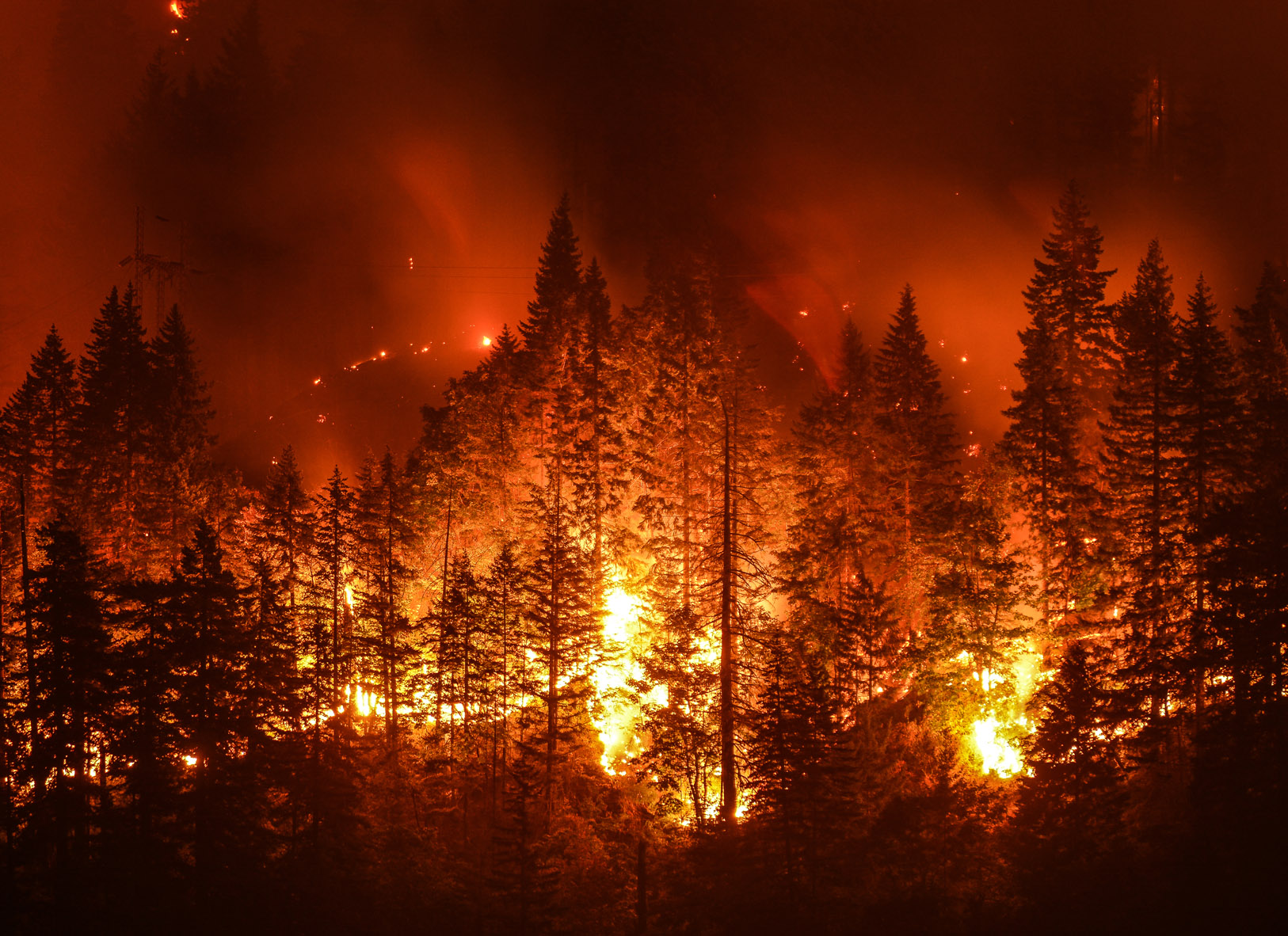 The global average temperature for July 2023 was the highest ever recorded and July 3rd was the world’s hottest day on record. We’ve seen scenes of wildfires raging across much of southern Europe, people suffering searing temperatures in south-west USA, southern India and western China, flash floods in South Korea, Japan and eastern USA. These are all directly related to global warming, which is causing weather systems to become more extreme. And as the planet continues to warm, so these problems will intensify.
The global average temperature for July 2023 was the highest ever recorded and July 3rd was the world’s hottest day on record. We’ve seen scenes of wildfires raging across much of southern Europe, people suffering searing temperatures in south-west USA, southern India and western China, flash floods in South Korea, Japan and eastern USA. These are all directly related to global warming, which is causing weather systems to become more extreme. And as the planet continues to warm, so these problems will intensify.
The Secretary General of the United Nations, Antonio Guterres, in a press conference on 27 July warned that:
Climate change is here. It is terrifying. And it is just the beginning. The era of global warming has ended; the era of global boiling has arrived. The air is unbreathable. The heat is unbearable. And the level of fossil-fuel profits and climate inaction is unacceptable. Leaders must lead. No more hesitancy. No more excuses. No more waiting for others to move first. There is simply no more time for that.
The environmental, human, social and economic impact of global warming is huge, but concentrated on just part of the world’s population. For many, a more variable climate is at worst an inconvenience – at least in the short term. But it is the short term that politicians are most concerned about when seeking to win the next election.
 Tackling climate change requires action to reduce carbon emissions now, even though the effects take many years. But one person’s emissions make only a minuscule contribution to global warming. So why not be selfish and carry on driving, flying off on holiday, using a gas boiler and eating large amounts of red meat? This is what many people want to do and governments know it. Many people do not like green policies as they involve sacrifice. Examples include higher fuel prices and restrictions on what you can do. So, despite the visions of fires, floods and destruction, governments are wary about raising fuel taxes, airport duties and charges to use old high-emission cars in cities; wary about raising taxes generally to provide subsidies for sustainable power generation; wary about banning new oil and gas fields that would reduce reliance on imported fuel.
Tackling climate change requires action to reduce carbon emissions now, even though the effects take many years. But one person’s emissions make only a minuscule contribution to global warming. So why not be selfish and carry on driving, flying off on holiday, using a gas boiler and eating large amounts of red meat? This is what many people want to do and governments know it. Many people do not like green policies as they involve sacrifice. Examples include higher fuel prices and restrictions on what you can do. So, despite the visions of fires, floods and destruction, governments are wary about raising fuel taxes, airport duties and charges to use old high-emission cars in cities; wary about raising taxes generally to provide subsidies for sustainable power generation; wary about banning new oil and gas fields that would reduce reliance on imported fuel.
Because the external costs of carbon emissions are so high and global, government action is required to change behaviour. Education can help and scenes of devastation from around the world may change the hearts and minds or some people. Also, the prospect of profits from cleaner and more fuel-efficient technology can help to spur innovation and investment. But to meet net zero targets still requires policies that are unpopular with many people who might be inconvenienced or have to pay higher petrol, energy and food prices, especially at a time when budgets are being squeezed by inflation.
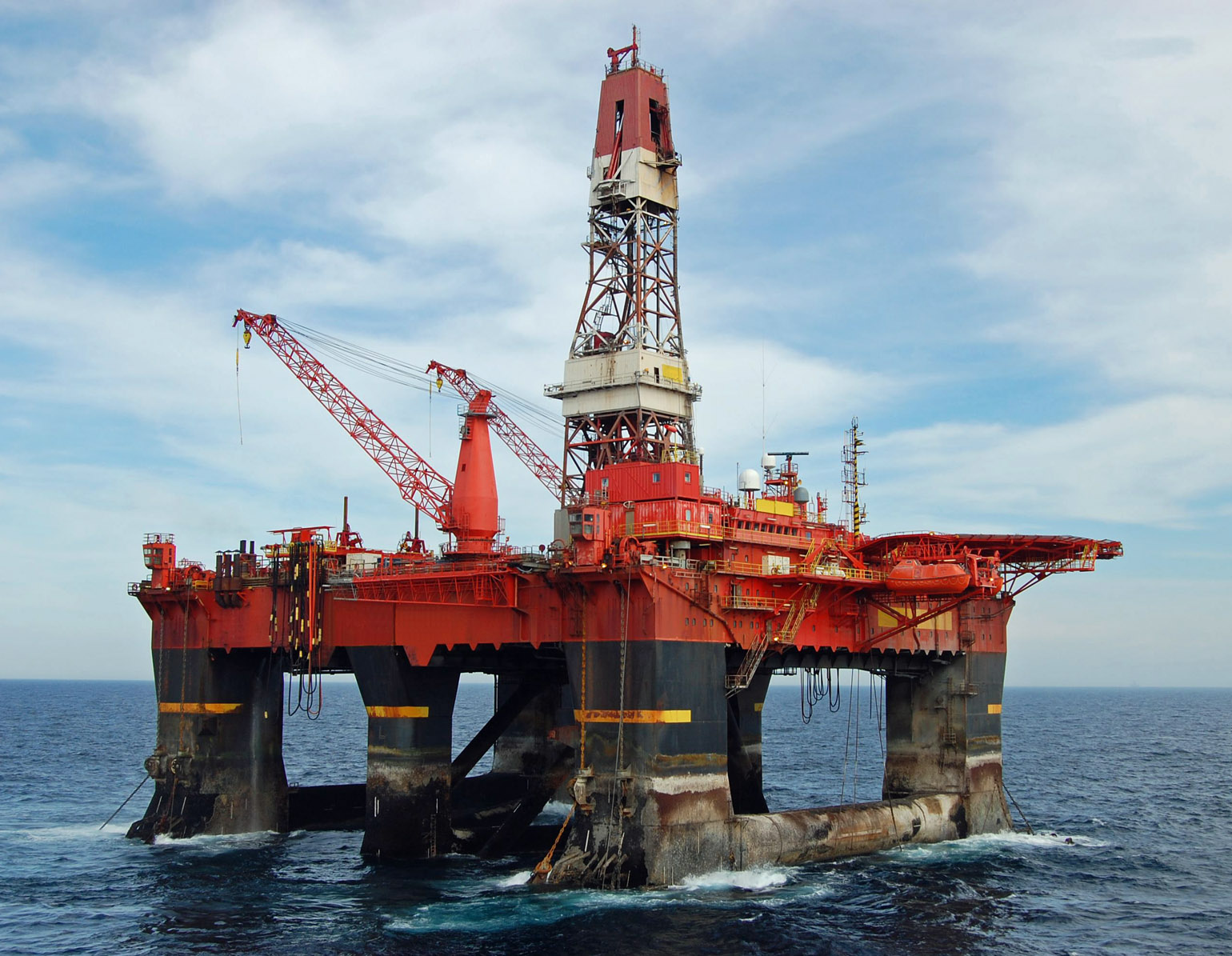 Part of the problem is a distributional one. The people most affected by the cost-of-living crisis and higher interest rates are those on lower incomes and with higher debts. Politicians know that it will be hard to win the votes of such people if they are faced with higher green taxes. As elections approach, politicians are likely to backtrack on many environmental commitments to appeal to such people.
Part of the problem is a distributional one. The people most affected by the cost-of-living crisis and higher interest rates are those on lower incomes and with higher debts. Politicians know that it will be hard to win the votes of such people if they are faced with higher green taxes. As elections approach, politicians are likely to backtrack on many environmental commitments to appeal to such people.
This is beginning to happen in the UK, with the government declaring that it is on the side of the motorist. Indeed, Rishi Sunak has just announced that the government will authorise more than 100 new licenses for new oil and gas wells in the North Sea. This is despite the United Nations, various other international bodies, climate scientists and charities calling for a halt to all licensing and funding of new oil and gas development from new and existing fields. The government argues that increased North Sea production would reduce the reliance on imported oil.
Video
Articles
- July 2023 the Hottest Ever Month on Record, Likely Warmest in ‘Tens of Thousands of Years’
The Wire, Aathira Perinchery (28/7/23)
- Climate threat ‘existential’ says Biden, as world faces hottest July
BBC News, Heather Sharp and Emma Owen (27/7/23)
- UN chief says Earth in ‘era of global boiling’, calls for radical action
Aljazeera (27/7/23)
- Why it’s time to prepare for the worst on climate change
Financial Times, Robert Pindyck (6/7/23)
- The planet heats, the world economy cools – the real global recession is ecological
The Guardian, Larry Elliott (9/7/23)
- Climate change will reshape global supply chains — it can reduce welfare on Earth by 20%: Ivan Rudick
The Economic Times (India), Srijana Mitra Das (30/6/23)
- Rishi Sunak defends granting new North Sea oil and gas licences
BBC News (31/7/23)
- The oil industry has succumbed to a dangerous new climate denialism
The Conversation, Adi Imsirovic (31/7/23)
- Dismay as Rishi Sunak vows to ‘max out’ UK fossil fuel reserves
The Guardian, Severin Carrell, Peter Walker and Helena Horton (31/7/23)
- What are the Conservatives’ green policies – and what could be scrapped
Sky News, Jennifer Scott (31/7/23)
- Rishi Sunak signals he is ready to soften UK green policies
Financial Times, George Parker and Lucy Fisher (24/7/23)
- Green campaigners fear UK policy backlash after ULEZ keeps Uxbridge Tory
Politico, Charlie Cooper and Bethany Dawson (23/7/23)
- Climate policy and economic inequality
VoxEU, Diego Känzig (25/6/23)
- The untapped potential of education in the battle against climate change
VoxEU, Noam Angrist, Kevin Winseck, Harry Anthony Patrinos and Joshua Graff Zivin (14/7/23)
Questions
- In what sense is the environment a ‘public good’? How is the concept of externalities relevant in analysing the private decisions made about the use of a public good?
- How may game theory be used to help understand the difficulties in reaching international agreement about climate change policies?
- What is meant by ‘net zero’? Is carbon capture and storage an acceptable alternative to cutting carbon emissions?
- In what ways could policies to tackle climate change be designed to reduce income inequality rather than increase it?
- What are the arguments for and against banning (a) petrol and diesel cars; (b) gas boilers; (c) fossil-fuel power stations? How much notice should be given if such bans are to be introduced?
- What is meant by ‘nudge theory’? In what ways could people be nudged into making greener decisions?
- What are the arguments for and against granting new licences for North Sea oil and gas drilling? Explain where you feel the balance of the arguments lies.

The Climate Change Pact agreed by leaders at the end of COP26 in Glasgow went further than many pessimists had forecast, but not far enough to meet the goal of keeping global warming to 1.5°C above pre-industrial levels. The Pact states that:
limiting global warming to 1.5°C requires rapid, deep and sustained reductions in global greenhouse gas emissions, including reducing global carbon dioxide emissions by 45 per cent by 2030 relative to the 2010 level and to net zero around mid-century, as well as deep reductions in other greenhouse gases.
So how far would the commitments made in Glasgow restrict global warming and what actions need to be put in place to meet these commitments?
Short-term commitments and long-term goals
According to Climate Action Tracker, the short-term commitments to action that countries set out would cause global warming of 2.4°C by the end of the century, the effects of which would be calamitous in terms of rising sea levels and extreme weather.
However, long-term commitments to goals, as opposed to specific actions, if turned into specific actions to meet the goals would restrict warming to around 1.8°C by the end of the century. These long-term goals include reaching net zero emissions by certain dates. For the majority of the 136 countries agreeing to reach net zero, the date they set was 2050, but for some developing countries, it was later. China, Brazil, Indonesia, Russia, Nigeria, Sri Lanka and Saudi Arabia, for example, set a date of 2060 and India of 2070. Some countries set an earlier target and others, such as Benin, Bhutan, Cambodia, Guyana, Liberia and Madagascar, claimed they had already reached zero net emissions.
Despite these target dates, Climate Action Tracker argues that only 6 per cent of countries pledging net zero have robust policies in place to meet the targets. The problem is that actions are required by firms and individuals. They must cut their direct emissions and reduce the consumption of products whose production involved emissions.
 Governments can incentivise individuals and firms through emissions and product taxes, through carbon pricing, through cap-and-trade schemes, through subsidies on green investment, production and consumption, through legal limits on emissions, through trying to change behaviour by education campaigns, and so on. In each case, the extent to which individuals and firms will respond is hard to predict. People may want to reduce global warming and yet be reluctant to change their own behaviour, seeing themselves as too insignificant to make any difference and blaming big business, governments or rich individuals. It is important, therefore, for governments to get incentive mechanisms right to achieve the stated targets.
Governments can incentivise individuals and firms through emissions and product taxes, through carbon pricing, through cap-and-trade schemes, through subsidies on green investment, production and consumption, through legal limits on emissions, through trying to change behaviour by education campaigns, and so on. In each case, the extent to which individuals and firms will respond is hard to predict. People may want to reduce global warming and yet be reluctant to change their own behaviour, seeing themselves as too insignificant to make any difference and blaming big business, governments or rich individuals. It is important, therefore, for governments to get incentive mechanisms right to achieve the stated targets.
Let us turn to some specific targets specified in the Climate Change Pact.
Phasing out fossil fuel subsidies
Paragraph 20 of the Climate Change Pact
Calls upon Parties to accelerate … efforts towards the … phase-out of inefficient fossil fuel subsidies, while providing targeted support to the poorest and most vulnerable in line with national circumstances and recognizing the need for support towards a just transition.
Production subsidies include tax breaks or direct payments that reduce the cost of producing coal, oil or gas. Consumption subsidies cut fuel prices for the end user, such as by fixing the price at the petrol pump below the market rate. They are often justified as a way of making energy cheaper for poorer people. In fact, they provide a bigger benefit to wealthier people, who are larger users of energy. A more efficient way of helping the poor would be through benefits or general tax relief. Removing consumption subsidies in 32 countries alone would, according to International Institute for Sustainable Development, cut greenhouse gas emission by an average of 6 per cent by 2025.
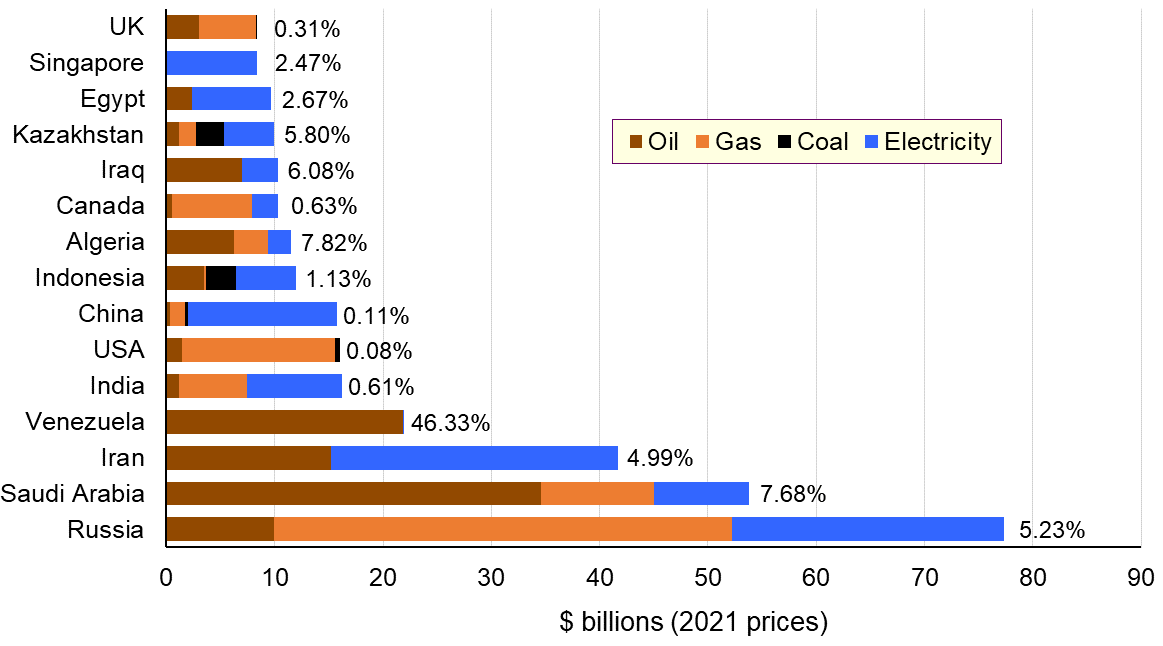 The chart shows the 15 countries providing the largest amount of support to fossil fuel industries in 2020 (in 2021 prices). The bars are in billions of dollars and the percentage of GDP is also given for each country. Subsidies include both production and consumption subsidies. (Click here for a PowerPoint of the chart.) In addition to the direct subsidies shown in the chart, there are the indirect costs of subsidies, including pollution, environmental destruction and the impact on the climate. According to the IMF, these amounted to $5.4 trillion in 2020.
The chart shows the 15 countries providing the largest amount of support to fossil fuel industries in 2020 (in 2021 prices). The bars are in billions of dollars and the percentage of GDP is also given for each country. Subsidies include both production and consumption subsidies. (Click here for a PowerPoint of the chart.) In addition to the direct subsidies shown in the chart, there are the indirect costs of subsidies, including pollution, environmental destruction and the impact on the climate. According to the IMF, these amounted to $5.4 trillion in 2020.
But getting countries to agree on a path to cutting subsidies, when conditions vary enormously from one country to another, proved very difficult.
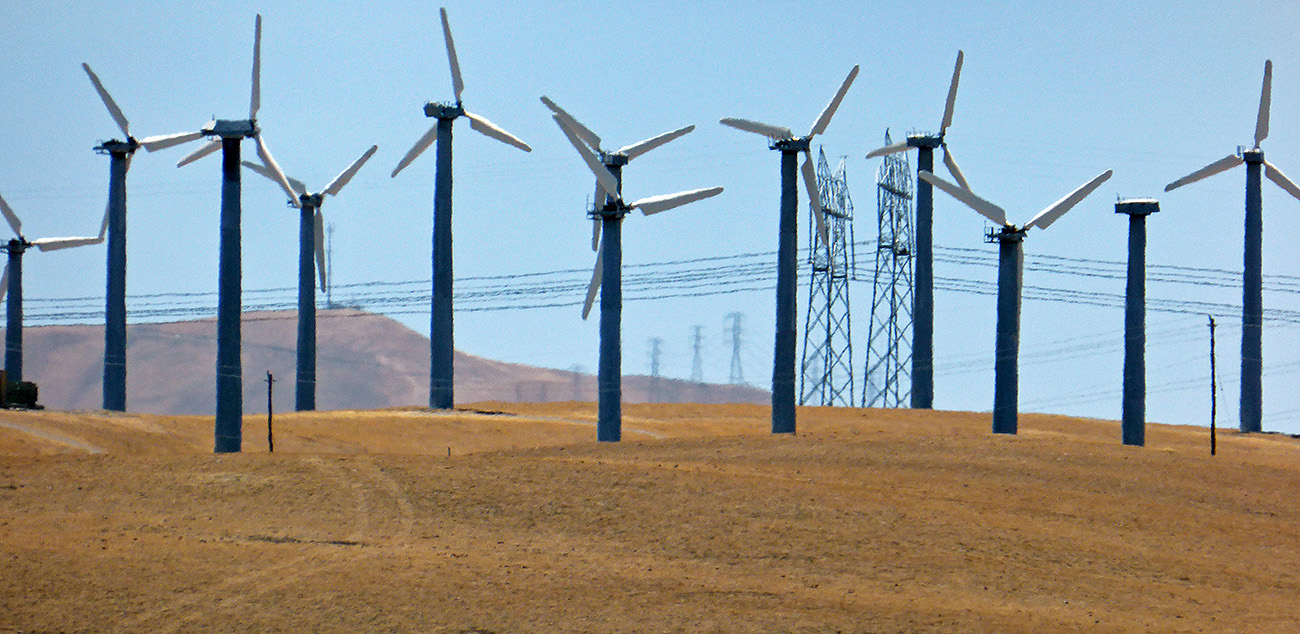 The first draft of the conference agreement called for countries to ‘to accelerate the phasing-out of coal and subsidies for fossil fuels’. But, after objections from major coal producing countries, such as China, India and Australia, this was weakened to calling on countries to accelerate the shift to clean energy systems ‘by scaling up the deployment of clean power generation and energy efficiency measures, including accelerating efforts towards the phasedown of unabated coal power and phase-out of inefficient fossil fuel subsidies’. (‘Unabated’ coal power refers to power generation with no carbon capture.) Changing ‘phasing-out’ to ‘the phasedown’ caused consternation among many delegates who saw this as a substantial weakening of the drive to end the use of coal.
The first draft of the conference agreement called for countries to ‘to accelerate the phasing-out of coal and subsidies for fossil fuels’. But, after objections from major coal producing countries, such as China, India and Australia, this was weakened to calling on countries to accelerate the shift to clean energy systems ‘by scaling up the deployment of clean power generation and energy efficiency measures, including accelerating efforts towards the phasedown of unabated coal power and phase-out of inefficient fossil fuel subsidies’. (‘Unabated’ coal power refers to power generation with no carbon capture.) Changing ‘phasing-out’ to ‘the phasedown’ caused consternation among many delegates who saw this as a substantial weakening of the drive to end the use of coal.
Another problem is in defining ‘inefficient’ subsidies. Countries are likely to define them in a way that suits them.
The key question was the extent to which countries would actually adopt such measures and what the details would be. Would they be strong enough? This remained to be seen.
As an article in the journal, Nature, points out:
There are three main barriers to removing production subsidies … First, fossil-fuel companies are powerful political groups. Second, there are legitimate concerns about job losses in communities that have few alternative employment options. And third, people often worry that rising energy prices might depress economic growth or trigger inflation.
The other question with the phasing out of subsidies is how and how much would there be ‘targeted support to the poorest and most vulnerable in line with national circumstances’.
Financial support for developing countries
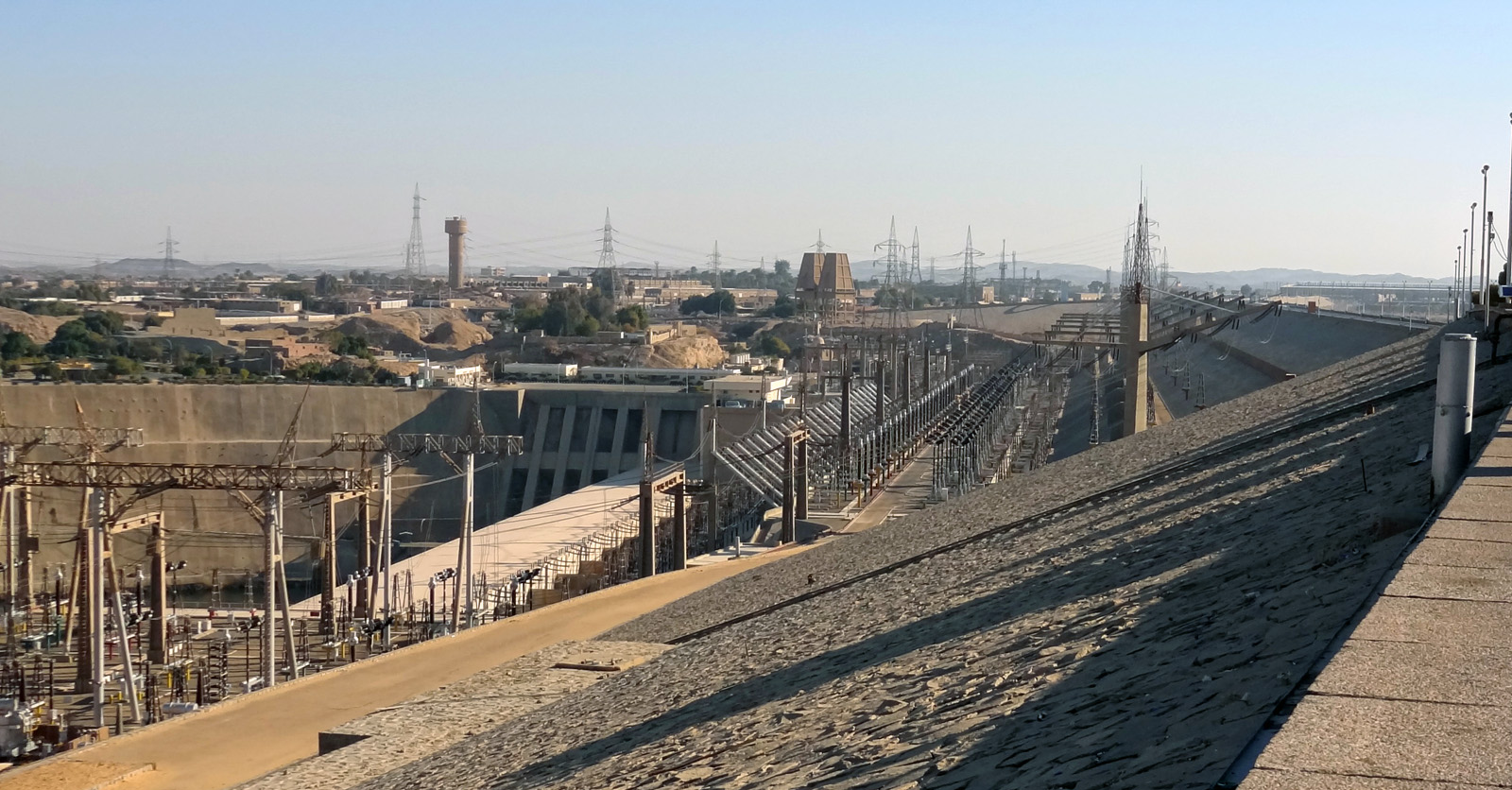 Transitioning to a low-carbon economy and investing in measures to protect people from rising sea levels, floods, droughts, fires, etc. costs money. With many developing countries facing serious financial problems, especially in the light of measures to support their economies and healthcare systems to mitigate the effects of COVID-19, support is needed from the developed world.
Transitioning to a low-carbon economy and investing in measures to protect people from rising sea levels, floods, droughts, fires, etc. costs money. With many developing countries facing serious financial problems, especially in the light of measures to support their economies and healthcare systems to mitigate the effects of COVID-19, support is needed from the developed world.
In the COP21 Paris Agreement in 2015, developed countries pledged $100 billion by 2020 to support mitigation of and adaptation to the effects of climate change by developing countries. But the target was not reached. The COP26 Pact urged ‘developed country Parties to fully deliver on the $100 billion goal urgently and through to 2025’. It also emphasised the importance of transparency in the implementation of their pledges. The proposal was also discussed to set up a trillion dollar per year fund from 2025, but no agreement was reached.
It remains to be seen just how much support will be given.
Then there was the question of compensating developing countries for the loss and damage which has already resulted from climate change. Large historical polluters, such as the USA, the UK and various EU countries, were unwilling to agree to a compensation mechanism, fearing that any recognition of culpability could make them open to lawsuits and demands for financial compensation.
Other decisions
- More than 100 countries at the meeting agreed to cut global methane emissions by at least 30 per cent from 2020 levels by 2030. Methane is a more powerful but shorter-living greenhouse gas than carbon. It is responsible for about a third of all human-generated global warming. China, India and Russia, however, did not sign up.
 Again, more than 100 countries agreed to stop deforestation by 2030. These countries include Indonesia and Brazil, which has been heavily criticised for allowing large parts of the Amazon rainforest to be cleared for farming, such that the Amazon region in recent years has been a net emitter of carbon from the felling and burning of trees. The pledge has been met with considerable cynicism, however, as it unclear how it will be policed. Much of the deforestation around the world is already illegal but goes ahead anyway.
Again, more than 100 countries agreed to stop deforestation by 2030. These countries include Indonesia and Brazil, which has been heavily criticised for allowing large parts of the Amazon rainforest to be cleared for farming, such that the Amazon region in recent years has been a net emitter of carbon from the felling and burning of trees. The pledge has been met with considerable cynicism, however, as it unclear how it will be policed. Much of the deforestation around the world is already illegal but goes ahead anyway.- A mechanism for trading carbon credits was agreed. This allows countries which plant forests or build wind farms to earn credits. However, it may simply provide a mechanism for rich countries and businesses to keep emitting as usual by buying credits.
- Forty-five countries pledged to invest in green agricultural practices to make farming more sustainable.
- Twenty-two countries signed a declaration to create zero-emission maritime shipping routes.
- The USA and China signed a joint declaration promising to boost co-operation over the next decade on various climate actions, including reducing methane emissions, tackling deforestation and regulating decarbonisation.
 Blah, blah, blah or real action?
Blah, blah, blah or real action?
Many of the decisions merely represent targets. What is essential is for countries clearly to spell out the mechanisms they will use for achieving them. So far there is too little detail. It was agreed, therefore, to reconvene in a year’s time at COP27 in Egypt. Countries will be expected to spell out in detail what actions they are taking to meet their emissions targets and other targets such as ending deforestation and reducing coal-fired generation.
Articles
- COP26 ended with the Glasgow Climate Pact. Here’s where it succeeded and failed
CNN, Angela Dewan and Amy Cassidy (14/11/21)
- Good COP, Bad COP: Separating heat from light at the climate summit
Ing, Samuel Abettan, Gerben Hieminga and Coco Zhang (15/11/21)
- COP26: What was agreed at the Glasgow climate conference?
BBC News (15/11/21)
- Five Things You Need to Know About The New Glasgow Climate Pact
The Conversation, Simon Lewis and Mark Maslin (13/11/21)
- Infographic: What has your country pledged at COP26?
Aljazeera, Hanna Duggal (14/11/21)
- Cop26: world on track for disastrous heating of more than 2.4C, says key report
The Guardian, Fiona Harvey (9/11/21)
- Cop26 took us one step closer to combating the climate crisis
The Guardian, Christiana Figueres (15/11/21)
- After the failure of Cop26, there’s only one last hope for our survival
The Guardian, George Monbiot (14/11/21)
- Why fossil fuel subsidies are so hard to kill
Nature, Jocelyn Timperley (20/10/21)
- The COP26 blah blah blah detector
Rappler, Elpidio Peria (16/11/21)
Podcasts
Videos
Report
Document
Questions
- What were the main achievements of COP26?
- What were the main failings of COP26?
- How can people be incentivised to reduce their direct and indirect greenhouse gas emissions?
- How is game theory relevant to understanding the difficulties in achieving global net zero emissions?
- Should developing countries be required to give up coal power?
- If the world is to achieve net zero greenhouse gas emissions, should all countries achieve net zero or should some countries achieve net negative emissions to allow others to continue with net positive emissions (albeit at a lower level)?

The transition towards clean energy in combination with a shortfall in supply has seen the price of raw uranium, also known as ‘yellowcake’, rise almost 60 per cent in recent weeks. It is now trading at over $50 a pound – a nine-year high. The market has been described as being at a ‘tipping point’. Given the recent boom in the market, the current conditions could tip the balance towards an era of rising uranium prices.
What is uranium?
Uranium is a heavy metal which has been used as a source of concentrated energy for over 60 years. Uranium ore can be mined from underground, milled, and then sold. It is then used in a nuclear reactor for electricity generation. About 10% of the world’s electricity is generated from uranium in nuclear reactors. There are some 445 nuclear reactors operating in 32 countries. It is the most energy-dense and efficient fuel source we have, with just ten uranium pellets able to power the average household for an entire year.
In March 2011, Japan’s most powerful earthquake on record triggered a tsunami, which then caused a meltdown at a nuclear power plant in Fukushima. It forced residents from their homes as radiation leaked from the plant. Since the Fukushima accident, uranium prices had been on a downtrend trend – enough to force several miners to suspend or scale back operations.
However, there has been a 42 per cent increase in the price of the metal in the first nine months of 2021 alone.
Demand for uranium
Since launching in July, a new investment trust, run by Canadian asset manager Sprott, has snapped up about 6m pounds of physical uranium, worth about $240m. This aggressive buying has helped push prices of uranium to more than $40 per pound, up from $30 at the start of the year. In the first part of September alone, prices surged by around 40%, outperforming all other major commodities. In just a few weeks, millions of pounds of supply were scooped up by the Sprott Physical Uranium Trust. This puts pressure on utilities that need to secure supplies of the commodity for electricity generation.
This increased demand is occurring at precisely the same time as countries and companies around the world are committing to net-zero carbon targets. As a result, nuclear power companies are now facing competition for supplies of uranium from financial investors, who are betting on sharply higher prices and demand for the radioactive material used to fuel reactors. This boost in demand is said to be due to uranium being used as a low-carbon energy source, despite the radioactive waste problem that comes with it. Investors are betting that nuclear power will be a key part of the move away from fossil fuels.
Production from world uranium mines has in recent years supplied 90% of the requirements of power utilities for uranium, with the current global mine supply expected to be about 125m pounds for 2021. In addition, there are secondary sources such as commercial and military stockpiles. However, according to the World Nuclear Association, demand for uranium is expected to climb from about 162m pounds this year to 206m pounds in 2030, and to 292m pounds by 2040. This is largely driven by increased power generation in China. China is planning a big increase in its nuclear power capacity over the next decade as the country seeks to cut its emissions.
Supply of uranium
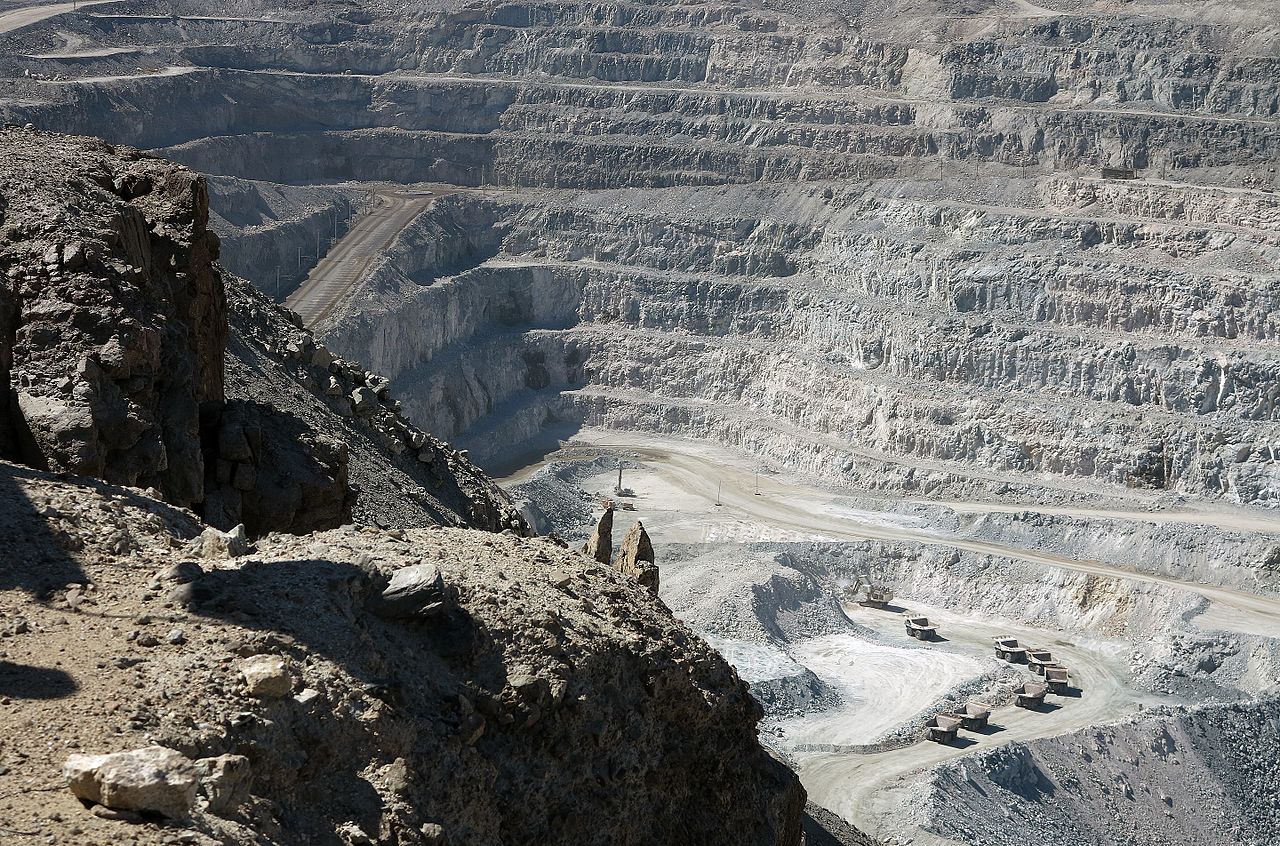 Although uranium is relatively abundant in the Earth’s crust, not all uranium deposits are economically recoverable. While some countries have uranium resources that can be mined profitably when prices are low, others do not. Kazakhstan is the largest producer of uranium and in 2019 produced more uranium than the second, third, and fourth-largest producers combined.
Although uranium is relatively abundant in the Earth’s crust, not all uranium deposits are economically recoverable. While some countries have uranium resources that can be mined profitably when prices are low, others do not. Kazakhstan is the largest producer of uranium and in 2019 produced more uranium than the second, third, and fourth-largest producers combined.
The big issue is that supply to the market is falling significantly. For deliveries that would start in 2022, Kazakh producer, Kazatomprom, is now discussing the possibility of supplying the metal directly to Sprott. However, it also warned of the risk that its mines would not reach their output target for 2021, and it said earlier this year that it would keep its production at reduced levels through 2023. In addition to this, the recent surge in buying is also reducing the inventories that accumulated after the Fukushima accident.
The supply of uranium is set to fall 15 per cent by 2025 and by 50 per cent by 2030. This is mainly due to a lack of investment in new mines. The lack of new uranium mines will mean the price has to move higher. Namibian mines, accounting for 8 per cent of world supply, are approaching the end of their lives. Cameco of Canada, another important source, has shut one large pit because of uneconomic prices. According to BMO Capital, a mine supply deficit since 2019 will continue.
Supply has also been affected by the pandemic. The boom in demand has coincided with historically low prices and pandemic-driven mine disruptions, prompting uranium producers to buy from the spot market to fulfil long-term contracts with consumers. Some of the largest mining operations in Canada and Kazakhstan had to suspend production temporarily due to a shortage of workers.
Adding to the security of supply concerns is the role of commercial and state-owned entities in the uranium market. Uranium is a highly trade-dependent commodity with international trade policies highlighting the disconnect between where uranium is produced and where it is consumed. About 80% of primary production comes from countries that consume little-to-no uranium, and nearly 90% of uranium consumption occurs in countries that have little-to-no primary production. As a result, government-driven trade policies can be particularly disruptive for the uranium market. It is argued that the risk to uranium supply may create a renewed focus on ensuring availability of long-term supply to fuel nuclear reactors.
The role of financial players
Financial players have been accelerating the recent recovery in the price of uranium, with large-scale speculative buying and withholding of supply. But it can be argued that this would not have occurred if there were not a fundamental and substantial shortage.
 If investors keep buying uranium, analysts expect utility companies will come under pressure to replace long-term supply agreements before they expire. At the moment, long-term contracts cover 98 per cent of the uranium needed by US utility companies. But that figure drops to 84 per cent next year, and 55 per cent by 2025, according to uranium investment company, Yellow Cake.
If investors keep buying uranium, analysts expect utility companies will come under pressure to replace long-term supply agreements before they expire. At the moment, long-term contracts cover 98 per cent of the uranium needed by US utility companies. But that figure drops to 84 per cent next year, and 55 per cent by 2025, according to uranium investment company, Yellow Cake.
As annual supply declines, demand for uranium from producers and financial players increases, and with trade policy potentially restricting access to some markets, it is believed the pounds available in the spot market will not be adequate to satisfy the growing backlog of long-term demand. As a result, companies expect there will be increased competition to secure uranium under long-term contracts on terms that will ensure the availability of reliable primary supply to meet growing demand.
What will the future look like?
Many countries are turning their attention to nuclear power in order to become net-zero economies. Even in Japan, nuclear generation has slowly been returning. It is argued that nuclear power is needed to some degree for the country to achieve its pollution-curbing goals. However, not all nations are re-embracing nuclear. Germany, for example, is set to shut its last reactor next year.
The concern is whether the recent gains in investor demand is enough to underpin the market. It can be argued that even before the recent price rally started, demand for uranium from the investment sector was already growing. However, observers of the market have suggested that just as quickly as uranium skyrocketed, prices may now be hitting the brakes. Producer stocks that got swept up in the frenzy seem to have peaked. In addition, the world’s top uranium miner Kazatomprom has warned that the recent price action was being fuelled by financial investors rather than the utilities that use the radioactive metal as fuel in their reactors. On the other hand, it is argued that this pickup in the spot market will be the catalyst to push more utilities to get involved in term contracting.
Despite the impact of the pandemic on global energy demand, it is now growing again. Gas and other energy shortages are being seen and the price of gas has been rising rapidly. This rise in energy prices plus a focus on carbon-free generation is likely to continue driving demand for nuclear power and hence for uranium. In addition, producers have warned of supply shortages in the long term as investors scoop up physical inventory and new mines are not starting quickly enough. Thus nuclear’s growing role in the clean energy transition, in addition to a supply shortfall, could turn the tide for the uranium industry.
Articles
Data
Questions
- Using the uranium market as an example, describe the relationship between an increase in demand and the market price.
- Explain whether the supply of uranium would be price elastic or inelastic in (a) the short run; (b) the long run.
- What is the role of speculation in determining the recent movements in the price of uranium and likely future price movements?
- Given your answers to the above questions, draw supply and demand diagrams to illustrate (a) the recent increase in the market price of uranium; (b) the likely price of uranium in five years from now.
 Every year, world leaders gather to find ways of limiting global warming. The latest of these ‘COP’ meetings, COP30, is in Belém, Brazil from 10 to 20 November 2025. COP stands for ‘Conference of the Parties’, the decision-making body of the United Nations Framework Convention on Climate Change (UNFCCC).
Every year, world leaders gather to find ways of limiting global warming. The latest of these ‘COP’ meetings, COP30, is in Belém, Brazil from 10 to 20 November 2025. COP stands for ‘Conference of the Parties’, the decision-making body of the United Nations Framework Convention on Climate Change (UNFCCC). Since 2020, each country has been required to submit its own emissions-reduction targets, known as ‘nationally determined contributions’ (NDCs), and the actions it will take to meet them. Every five years each country must submit a new NDC more ambitious than the last. New NDCs are due this year. As of 12 November, 112 of the 197 countries had submitted a new NDC (including the USA, China, the EU and the UK). These 112 countries account for around 71 per cent of global emissions.
Since 2020, each country has been required to submit its own emissions-reduction targets, known as ‘nationally determined contributions’ (NDCs), and the actions it will take to meet them. Every five years each country must submit a new NDC more ambitious than the last. New NDCs are due this year. As of 12 November, 112 of the 197 countries had submitted a new NDC (including the USA, China, the EU and the UK). These 112 countries account for around 71 per cent of global emissions. As well as announcing that the USA will withdraw from the Paris Agreement in January 2026, since coming to office in 2025, President Trump has given billions of dollars of tax cuts to fossil fuel firms and allowed drilling for oil and gas on federal lands. At the same time, he has described renewable energy as ‘a joke’ that will bankrupt countries and has slashed subsidies and tax breaks for solar and wind power, withdrawn permits for wind and solar farms, and cut funding for green energy research.
As well as announcing that the USA will withdraw from the Paris Agreement in January 2026, since coming to office in 2025, President Trump has given billions of dollars of tax cuts to fossil fuel firms and allowed drilling for oil and gas on federal lands. At the same time, he has described renewable energy as ‘a joke’ that will bankrupt countries and has slashed subsidies and tax breaks for solar and wind power, withdrawn permits for wind and solar farms, and cut funding for green energy research. Climate change is directly caused by market failures. One of the most important of these is that the atmosphere is a common resource: it is not privately owned; it is a global ‘commons’. Individuals and firms use it at a zero price. If the price of any good or service to the user is zero, there is no incentive to economise on its use. Thus for the emitter there are no private costs of using the atmosphere in this way as a ‘dump’ for their emissions and, in a free market, no incentive to reduce the climate costs.
Climate change is directly caused by market failures. One of the most important of these is that the atmosphere is a common resource: it is not privately owned; it is a global ‘commons’. Individuals and firms use it at a zero price. If the price of any good or service to the user is zero, there is no incentive to economise on its use. Thus for the emitter there are no private costs of using the atmosphere in this way as a ‘dump’ for their emissions and, in a free market, no incentive to reduce the climate costs. These climate costs are external costs to the firm and are illustrated in the figure. It shows an industry that emits CO2. To keep the analysis simple, assume that it is a perfectly competitive industry with demand and supply given by curves D and S, which are equal to the marginal private benefits (MPB) and marginal private costs (MPC), respectively. There are no externalities on the demand side and hence MPB equals the marginal social cost (MSB). Market equilibrium is at point a, with output at Qpc and price at Ppc. (Click here for a PowerPoint.)
These climate costs are external costs to the firm and are illustrated in the figure. It shows an industry that emits CO2. To keep the analysis simple, assume that it is a perfectly competitive industry with demand and supply given by curves D and S, which are equal to the marginal private benefits (MPB) and marginal private costs (MPC), respectively. There are no externalities on the demand side and hence MPB equals the marginal social cost (MSB). Market equilibrium is at point a, with output at Qpc and price at Ppc. (Click here for a PowerPoint.) In other words, other things being equal, the free market overproduces products with climate externalities. If the output is to be reduced to the social optimum of Q*, then the government will need to take measures such as those advocated in the Paris Agreement. These could include imposing taxes on products, such as electricity generated by fossil fuels, or on the emissions themselves. Or green alternatives, such as wind power, could be subsidised.
In other words, other things being equal, the free market overproduces products with climate externalities. If the output is to be reduced to the social optimum of Q*, then the government will need to take measures such as those advocated in the Paris Agreement. These could include imposing taxes on products, such as electricity generated by fossil fuels, or on the emissions themselves. Or green alternatives, such as wind power, could be subsidised. The USA is not attending COP30 in Brazil. Nor is the Chinese leader, Xi Jinping. However, there are growing opportunities for translating aims into practical policies for specific sectors, such as energy, transport and carbon-intensive industries. These policies may require some degree of government action – taxes, subsidies or regulation – to internalise climate externalities. But increasingly, green alternatives are becoming economically viable without subsidies or with just initial government funding to ‘crowd in’ private investment, which will then attract further private capital as external economies of scale kick in. Increasingly investors will find profitable opportunities in climate-friendly projects.
The USA is not attending COP30 in Brazil. Nor is the Chinese leader, Xi Jinping. However, there are growing opportunities for translating aims into practical policies for specific sectors, such as energy, transport and carbon-intensive industries. These policies may require some degree of government action – taxes, subsidies or regulation – to internalise climate externalities. But increasingly, green alternatives are becoming economically viable without subsidies or with just initial government funding to ‘crowd in’ private investment, which will then attract further private capital as external economies of scale kick in. Increasingly investors will find profitable opportunities in climate-friendly projects. Could the world’s biggest polluter be its savior against climate change?
Could the world’s biggest polluter be its savior against climate change? Since 2020, each country has been required to submit its own emission-reduction targets, known as ‘nationally determined contributions’ (NDCs), and the actions it will take to meet them. Every five years each country must submit a new NDC more ambitious than the last.
Since 2020, each country has been required to submit its own emission-reduction targets, known as ‘nationally determined contributions’ (NDCs), and the actions it will take to meet them. Every five years each country must submit a new NDC more ambitious than the last. In April 2016 the USA signed the Paris Agreement. As stated above, the Paris Agreement came into effect on 4 November 2016.
In April 2016 the USA signed the Paris Agreement. As stated above, the Paris Agreement came into effect on 4 November 2016.  Withdrawal from the Paris Agreement and promoting fossil fuels will increase US emissions. Scientific consensus is that this will have a negative effect on climate change. Only part of these climate costs will be borne by the USA, although the severity of recent fires in California, fanned by strong Santa Ana winds, and more violent hurricanes are two examples of costs of climate change to the USA itself.
Withdrawal from the Paris Agreement and promoting fossil fuels will increase US emissions. Scientific consensus is that this will have a negative effect on climate change. Only part of these climate costs will be borne by the USA, although the severity of recent fires in California, fanned by strong Santa Ana winds, and more violent hurricanes are two examples of costs of climate change to the USA itself.
 The global average temperature for July 2023 was the highest ever recorded and July 3rd was the world’s hottest day on record. We’ve seen scenes of wildfires raging across much of southern Europe, people suffering searing temperatures in south-west USA, southern India and western China, flash floods in South Korea, Japan and eastern USA. These are all directly related to global warming, which is causing weather systems to become more extreme. And as the planet continues to warm, so these problems will intensify.
The global average temperature for July 2023 was the highest ever recorded and July 3rd was the world’s hottest day on record. We’ve seen scenes of wildfires raging across much of southern Europe, people suffering searing temperatures in south-west USA, southern India and western China, flash floods in South Korea, Japan and eastern USA. These are all directly related to global warming, which is causing weather systems to become more extreme. And as the planet continues to warm, so these problems will intensify. Tackling climate change requires action to reduce carbon emissions now, even though the effects take many years. But one person’s emissions make only a minuscule contribution to global warming. So why not be selfish and carry on driving, flying off on holiday, using a gas boiler and eating large amounts of red meat? This is what many people want to do and governments know it. Many people do not like green policies as they involve sacrifice. Examples include higher fuel prices and restrictions on what you can do. So, despite the visions of fires, floods and destruction, governments are wary about raising fuel taxes, airport duties and charges to use old high-emission cars in cities; wary about raising taxes generally to provide subsidies for sustainable power generation; wary about banning new oil and gas fields that would reduce reliance on imported fuel.
Tackling climate change requires action to reduce carbon emissions now, even though the effects take many years. But one person’s emissions make only a minuscule contribution to global warming. So why not be selfish and carry on driving, flying off on holiday, using a gas boiler and eating large amounts of red meat? This is what many people want to do and governments know it. Many people do not like green policies as they involve sacrifice. Examples include higher fuel prices and restrictions on what you can do. So, despite the visions of fires, floods and destruction, governments are wary about raising fuel taxes, airport duties and charges to use old high-emission cars in cities; wary about raising taxes generally to provide subsidies for sustainable power generation; wary about banning new oil and gas fields that would reduce reliance on imported fuel. Part of the problem is a distributional one. The people most affected by the cost-of-living crisis and higher interest rates are those on lower incomes and with higher debts. Politicians know that it will be hard to win the votes of such people if they are faced with higher green taxes. As elections approach, politicians are likely to backtrack on many environmental commitments to appeal to such people.
Part of the problem is a distributional one. The people most affected by the cost-of-living crisis and higher interest rates are those on lower incomes and with higher debts. Politicians know that it will be hard to win the votes of such people if they are faced with higher green taxes. As elections approach, politicians are likely to backtrack on many environmental commitments to appeal to such people.
 The chart shows the 15 countries providing the largest amount of support to fossil fuel industries in 2020 (in 2021 prices). The bars are in billions of dollars and the percentage of GDP is also given for each country. Subsidies include both production and consumption subsidies. (Click
The chart shows the 15 countries providing the largest amount of support to fossil fuel industries in 2020 (in 2021 prices). The bars are in billions of dollars and the percentage of GDP is also given for each country. Subsidies include both production and consumption subsidies. (Click  The first draft of the conference agreement called for countries to ‘to accelerate the phasing-out of coal and subsidies for fossil fuels’. But, after objections from major coal producing countries, such as China, India and Australia, this was weakened to calling on countries to accelerate the shift to clean energy systems ‘by scaling up the deployment of clean power generation and energy efficiency measures, including accelerating efforts towards the phasedown of unabated coal power and phase-out of inefficient fossil fuel subsidies’. (‘Unabated’ coal power refers to power generation with no carbon capture.) Changing ‘phasing-out’ to ‘the phasedown’ caused consternation among many delegates who saw this as a substantial weakening of the drive to end the use of coal.
The first draft of the conference agreement called for countries to ‘to accelerate the phasing-out of coal and subsidies for fossil fuels’. But, after objections from major coal producing countries, such as China, India and Australia, this was weakened to calling on countries to accelerate the shift to clean energy systems ‘by scaling up the deployment of clean power generation and energy efficiency measures, including accelerating efforts towards the phasedown of unabated coal power and phase-out of inefficient fossil fuel subsidies’. (‘Unabated’ coal power refers to power generation with no carbon capture.) Changing ‘phasing-out’ to ‘the phasedown’ caused consternation among many delegates who saw this as a substantial weakening of the drive to end the use of coal.  Transitioning to a low-carbon economy and investing in measures to protect people from rising sea levels, floods, droughts, fires, etc. costs money. With many developing countries facing serious financial problems, especially in the light of measures to support their economies and healthcare systems to mitigate the effects of COVID-19, support is needed from the developed world.
Transitioning to a low-carbon economy and investing in measures to protect people from rising sea levels, floods, droughts, fires, etc. costs money. With many developing countries facing serious financial problems, especially in the light of measures to support their economies and healthcare systems to mitigate the effects of COVID-19, support is needed from the developed world. Again, more than 100 countries agreed to stop deforestation by 2030. These countries include Indonesia and Brazil, which has been heavily criticised for allowing large parts of the Amazon rainforest to be cleared for farming, such that the Amazon region in recent years has been a net emitter of carbon from the felling and burning of trees. The pledge has been met with considerable cynicism, however, as it unclear how it will be policed. Much of the deforestation around the world is already illegal but goes ahead anyway.
Again, more than 100 countries agreed to stop deforestation by 2030. These countries include Indonesia and Brazil, which has been heavily criticised for allowing large parts of the Amazon rainforest to be cleared for farming, such that the Amazon region in recent years has been a net emitter of carbon from the felling and burning of trees. The pledge has been met with considerable cynicism, however, as it unclear how it will be policed. Much of the deforestation around the world is already illegal but goes ahead anyway. Blah, blah, blah or real action?
Blah, blah, blah or real action?
 Although uranium is relatively abundant in the Earth’s crust, not all uranium deposits are economically recoverable. While some countries have uranium resources that can be mined profitably when prices are low, others do not. Kazakhstan is the largest producer of uranium and in 2019 produced more uranium than the second, third, and fourth-largest producers combined.
Although uranium is relatively abundant in the Earth’s crust, not all uranium deposits are economically recoverable. While some countries have uranium resources that can be mined profitably when prices are low, others do not. Kazakhstan is the largest producer of uranium and in 2019 produced more uranium than the second, third, and fourth-largest producers combined. If investors keep buying uranium, analysts expect utility companies will come under pressure to replace long-term supply agreements before they expire. At the moment, long-term contracts cover 98 per cent of the uranium needed by US utility companies. But that figure drops to 84 per cent next year, and 55 per cent by 2025, according to uranium investment company, Yellow Cake.
If investors keep buying uranium, analysts expect utility companies will come under pressure to replace long-term supply agreements before they expire. At the moment, long-term contracts cover 98 per cent of the uranium needed by US utility companies. But that figure drops to 84 per cent next year, and 55 per cent by 2025, according to uranium investment company, Yellow Cake.